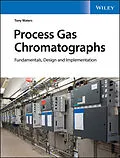A guide to the fundamentals of applied gas chromatography and the process gas chromatograph, with practical procedures for design and troubleshooting
This comprehensive resource provides the theory that underpins a full understanding of the fundamental techniques of gas chromatography and the process analyzer. Without relying on complex mathematics, the book addresses hands-on applications of gas chromatographs within process industries. The author - a noted expert on the topic - details both the scientific information needed to grasp the material presented and the practical applications for professionals working in the field.
Process Gas Chromatographs: Fundamentals, Design and Implementation comprises 15 chapters, a glossary of terms and a series of self-assessment questions and quizzes. This important resource:
* Describes practical procedures for design and troubleshooting
* Contains concise chapters that provide a structured course for advanced students in process engineering
* Reviews the fundamentals of applied gas chromatography
* Details the operation and maintenance of process gas chromatographs
* Offers a summary, and self-assessment questions, for every chapter
* Is written by an international expert in the field with extensive industry knowledge and teaching experience in courses on process sampling systems and gas chromatography
Written for process analyzer engineers and technicians, application engineers, and industrial environmental engineers, Process Gas Chromatographs: Fundamentals, Design and Implementation offers an essential guide to the basics of gas chromatography and reviews the applications of process gas chromatographs in industry today.
Autorentext
Tony Waters owns Analyzer Consulting Engineers, LLC in USA and is an Elected Fellow of International Society of Automation. Since 2000, he has been a Consultant in Process Analysis assisting refiners and chemical processors to achieve optimal use of process analyzers. He has twenty-five years' experience of working in the industry before setting up his own company, Measurementation, Inc. in 1986 to manufacture process analyzer systems.
Inhalt
Preface xix
Contributors xxi
Acknowledgments xxvii
Part One PGC fundamentals 1
1 An introduction 3
Chromatographic separation 3
The gas chromatograph 4
The basic instrument 4
The process instrument 5
The oven 7
Temperature control 7
Temperature programming 7
The sample injection valve 8
Laboratory and online practice 8
Plug injection 8
Gas sample injection 9
Liquid sample injection 9
The column 10
The separating device 10
It takes time 10
Multiple columns 11
SCI-FILE: On Column Types 12
Introduction to SCI-FILEs 12
Two kinds of column 12
Packed columns 12
Open-tubular columns 12
The detector 13
Making the measurements 13
The chromatogram 14
Knowledge Gained 18
Did you get it? 19
Self-assessment quiz: SAQ 01 19
Student evaluation test: SET 01 20
References 21
Cited 21
Figures 22
New technical terms 22
2 Peakshape 25
How columns work 25
What happens inside the column 26
How gas and liquid interact 26
Troubleshooting tips 28
How peaks form 28
Forming an equilibrium 28
The effect of movement 30
A peak appears 31
Effect of more equilibria 33
Some conclusions 34
Identical molecules different behavior 34
All peaks are symmetrical 35
More equilibria narrower peaks 35
More equilibria taller peaks 35
Retention at the apex 36
More equilibria same retention time 36
SCI-FILE: On Solubility 36
Solubility 36
Partition 36
Distribution 37
Limitations 37
Knowledge Gained 37
Did you get it? 38
Self-assessment quiz: SAQ 02 38
Student evaluation test: SET 02 38
References 40
Figures 40
Equation 41
Symbols 41
New technical terms 41
3 Separation 43
How peaks get separated 43
A more realistic explanation 43
A challenge question 46
Significance of the air peak 47
The answer 48
Measurements from chromatograms 50
A practical task 50
Typical calculations 51
Knowledge Gained 52
Did you get it? 53
Self-assessment quiz: SAQ 03 53
Student evaluation test: SET 03 53
References 55
Figures 55
Equations 55
Symbols 55
New technical terms 55
4 Peakpatterns 57
Migration rate 57
Predictable patterns in peak position 57
Space or time 57
Spatial or temporal separation 58
Predictable patterns in peak width 59
Distance or duration 59
SCI-FILE: On Chemical Names 60
Hydrocarbons 60
Shorthand notation 61
Predictable patterns in retention 61
The doubling rule 61
Challenge question 62
A process of elimination 62
Temperature programming 64
Relative retention 66
Separation and resolution 67
Resolution 67
Predictable patterns in resolution 69
Knowledge Gained 71
Did you get it? 72
Self-assessment quiz: SAQ 04 72
Student evaluation test: SET 04 72
References 74
Figures 74
Equations 74
Symbols 74
New technical terms 74
Part Two PGC analytics 77
5 Industrial gas chromatographs 7...
